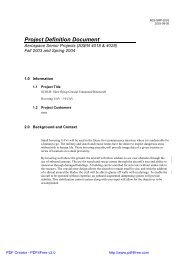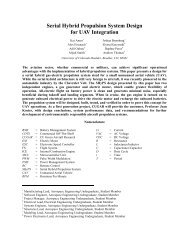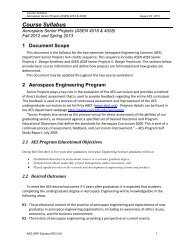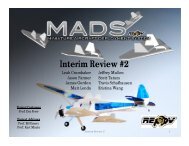PFR - Aerospace Engineering Sciences Senior Design Projects ...
PFR - Aerospace Engineering Sciences Senior Design Projects ...
PFR - Aerospace Engineering Sciences Senior Design Projects ...
You also want an ePaper? Increase the reach of your titles
YUMPU automatically turns print PDFs into web optimized ePapers that Google loves.
Project Final Report – CUDBF April 30 th , 2009<br />
ASEN 4028: <strong>Aerospace</strong> <strong>Senior</strong> <strong>Projects</strong><br />
13.2.2.5 Flight Test #6<br />
After the pilot had five flights to practice flying the Buff-2 Bomber, and several initial design<br />
problems had been fixed, the team felt comfortable installing the expensive Eagle Tree telemetry<br />
system on the aircraft. The purpose of flight test #6 was to collect numeric flight data for the first<br />
time on the empty aircraft. The goal was to gather data on takeoff speed, landing speed, top<br />
speed, and average power draw and compare these to the predicted values.<br />
Takeoff and landing speed were calculated using the standard value of 1.3*V stall . Without any<br />
payload, the takeoff and landing speed was predicted to be 25 mph. The actual takeoff and<br />
landing speeds were 27 mph and 23 mph respectively. The slight discrepancy in actual versus<br />
predicted speed is due to the fact that RC aircraft takeoff and landing speeds are based upon pilot<br />
judgment, and nearly impossible to fly at the exact chosen speeds.<br />
After climbing to a safe altitude, the pilot attempted a brief (less than 10 second) full power<br />
acceleration to see if the aircraft could reach the predicted top speed of 100 ft/s (68 mph). The<br />
aircraft reached a top speed of 70 mph, exceeding the 100 ft/s top speed requirement set in the<br />
PDD. The aircraft wasn’t flown at the top speed for an extended period of time because with RC<br />
aircraft, there is a possible risk that the aircraft becomes unstable at such high speeds. A plot of<br />
indicated airspeed versus time is shown in Figure 126. The airspeed is accurate to within 5 mph.<br />
This discrepancy is due to imperfect mounting of the pitot tubes on the aircraft. The top speed<br />
run occurred 130 seconds into the flight and lasted for only 10 seconds, allowing the aircraft to<br />
accelerate from 35 mph to 70 mph (plus or minus 3mph).<br />
70<br />
Indicated Airspeed vs. Time<br />
60<br />
Indicated Airspeed (mph)<br />
50<br />
40<br />
30<br />
20<br />
10<br />
0<br />
0 20 40 60 80 100 120 140 160 180 200<br />
Time (seconds)<br />
Figure 126: Indicated airspeed versus time on flight test #6<br />
Finally, average current draw was predicted to be 20 amps. The average current draw throughout<br />
the flight was 15.5 amps. A plot of the predicted versus actual current draw is shown in Figure<br />
142
















